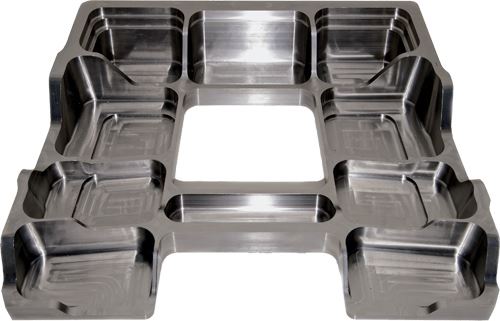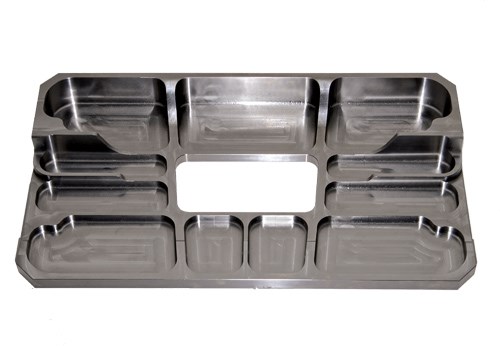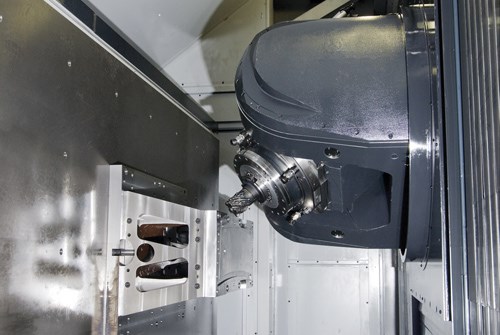For a job shop, machining titanium is difficult on two counts. One, it’s tough to make good parts. Two, it’s tough to do so and make good money at it. So titanium is both a technical and an economic challenge. To succeed in machining this material, a shop must be able to do it both productively and profitably. Process and cost considerations must be addressed together.
Some companies that machine titanium may be less concerned about expenses. An OEM, for example, may be able to pass the cost of critical titanium components to the consumer. The typical aerospace job shop doesn’t have that luxury. The only way to win and keep contracts is to implement technology that enables effective processing at an adequate margin. Nobody machines titanium for the love of it.
Providing this technology is the purview of suppliers serving shops involved in machining titanium. A number of machine tool builders, cutting tool manufacturers and related companies are focusing significant product development efforts on this market. One of these machine tool builders is Makino. This company recently sponsored a “Titanium Day” at its U.S. headquarters in Mason, Ohio (just north of Cincinnati) to promote titanium machining and showcase its products.
At this event, the company introduced what it considers a comprehensive approach to titanium machining. It combines a number of technical developments with clear implications for the economy of manufacturing titanium parts. This approach is worth a closer look because it emphasizes the special nature of titanium machining.
For example, titanium’s unique characteristics impose unforgiving restrictions on machining parameters that make it difficult to optimize metal removal rates, surface finish quality, dimensional accuracy and tool life. This usually comes down to a trade-off between metal removal rates and tool life.
Makino’s multi-pronged approach, called ADVANTiGE Machining Technologies, seeks to break out of this bind. It addresses spindle performance; coolant volume and pressure; vibration damping; machine rigidity; and cutting strategy in an integrated, synergistic manner. Together, the company says, these technologies result in both higher metal removal rates and longer tool life. Substantial improvements in both of these factors are key to productive, profitable titanium machining. In Makino’s case, the claim for its new approach is four times the productivity and twice the tool life previously attainable.
Putting it all Together
The centerpiece of the developments introduced at the event was the T4 five-axis HMC. This is currently the largest machine in the T-series, a line designed specifically for titanium aircraft parts, such as edge frames, pylons and bulkheads. (A somewhat smaller model in this series, the T2, is also available.) The T4 features all five of the machining technologies that work together to provide the advantage that overcomes limited metal removal rates and insufficient tool life.
The T4 is a large machine. It provides X, Y and Z travels of 4,200, 2,000 and 1,000 mm, respectively, and it can hold workpieces weighing as much as 5,000 kg. Adding to this impression of size are the massive column and bed structures, which the company says are necessary for rigidity. The other technologies, particularly those for reducing vibration, rely on this underlying rigidity to achieve their full potential.
The spindle is described as compact, but that is in comparison to a gear-driven spindle of equal capabilities. The T4’s direct-drive spindle is the most powerful the company has produced, providing higher torque, horsepower and clamping force than any predecessor. The spindle head also provides rotary motion for five-axis machining. Rotation is ±110 degrees in the A axis and 360 degrees continuous in the C axis.
The spindle also represents new technology for controlling chatter-causing vibration from heavy cutting forces. This is important because excessive vibration is the primary culprit in cutter wear and failure when machining titanium. Cutting tools for titanium are a major expense in the machining process, so increasing tool life has a direct effect on the bottomline. Makino’s Autonomic Spindle Technology addresses the spindle vibration issue. Sensors built into the spindle measure displacement caused by excessive cutting forces and transmit the data to the control unit. Algorithms in the control software process this data at high speed, and machining parameters are adjusted almost instantly. The response is usually a lower spindle speed (rpm), but a higher spindle speed is possible if it is nearer to a “sweet spot” in the machine’s dynamic resonance.
An active vibration damping system in the machine’s slideways complements the spindle technology. By adjusting frictional forces based on low-frequency vibration sensing, the system suppresses chatter resulting from structure resonances in real-time. The machine “tightens up” its way systems automatically to stifle chatter, so to speak.
Concerning Coolant
Two other developments built in to the T-series machines are related to coolant delivery. Titanium is readily damaged by heat, so keeping the workpiece cool and rapidly removing heat-bearing chips from the cutting zone are critical. Likewise, aggressive feed rates with multi-flute cutters call for forceful chip evacuation to prevent chip packing that can break a cutter.
Part of the answer is a system to deliver coolant at high pressure and volume directly to the cutting zone. This includes coolant delivery via overhead shower, from nozzles around the spindle nose and through the spindle bore. Coolant pressure can reach 1,500 psi and 55 gpm. The other part of the answer is a system that varies this pressure and volume to suit the machining operation. This is handled through enhanced M-code functionality in the control unit.
The company is also studying ways to “microsize” the coolant. The concept is to decrease the size of chemical particles in the coolant emulsion so they can penetrate the cutter/workpiece interface more effectively, thus enhancing the formula’s cooling and lubricating functions.
Cutter Strategies
According to the company, the combined effect of these machining technologies has two broad implications for cutting tool usage. One has already been mentioned. Suppressing sources of vibration in the spindle and machine structures substantially improves tool life. With extended tool life, high-performance cutting tools specially designed for titanium become the economical choice in the cost-of-cut calculation. Controlling vibration also permits higher feed rates and spindle speeds to boost metal removal rates.
As a second benefit, using innovative cutter designs becomes more feasible. A good example is the use of long-edge cutters, that is, milling tools with fluted edges for side-cutting pocket walls to full depth in one pass. To take advantage of such possibilities, cutting tool manufacturers are developing designs, such as variable-pitch flutes and inserts with variable rake angles.
Pallet Changing
Finally, the T4 is designed to reduce non-machining time. The machine has two pallets, each with an inclinable upright. With the upright fully inclined, large workpieces can be loaded from an overhead crane. With the upright raised, the pallet can present the workpiece to the spindle in a horizontal orientation for improved chip clearance and coolant flow.
A workpiece can be loaded and unloaded while a workpiece on a second pallet is being machined. According to the company, chip-to-chip time is two minutes.
More Manageable
The rules for machining titanium are changing. As machine tool builders, cutting tool manufacturers and other suppliers build on one another’s advances, producing titanium parts will become more manageable. That is to say, the process will be based on a firmer understanding of the machining forces involved, the interaction of numerous variables and the interplay of all cost factors.
Titanium R&D Center
 The new titanium R&D center will be located at Makino’s facility in Mason, Ohio.
The new titanium R&D center will be located at Makino’s facility in Mason, Ohio.
Makino has chosen to locate its new Global Titanium Research and Development Center at its Mason, Ohio facility, where a group of engineers will further the development of titanium milling technologies. The facility will include machine tools, CMMs and other tools necessary to further titanium machining technologies. Also, experts who specialize in processing this tough material will be at hand.
“Titanium machining is very process driven, meaning the machine tool, cutting tools, machining process and coolants must all be developed and integrated specific to titanium’s material properties,” says Tom Clark, vice president of Makino. The center’s staff will work with vendors, suppliers and partners to develop improvements for all types of titanium applications.
According to the company, the Mason facility was chosen because of the growing importance of titanium in the aerospace industry, which is concentrated in North America.


















 The new titanium R&D center will be located at Makino’s facility in Mason, Ohio.
The new titanium R&D center will be located at Makino’s facility in Mason, Ohio.











